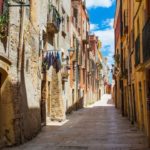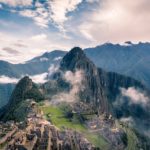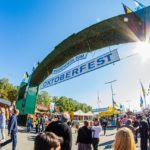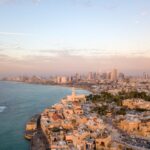A Year of Florence Festivals

Centuries of history and modern daily life join you as you walk through the historic center of Florence, the beautiful open-air museum that is one of Italy’s 50 UNESCO World Heritage Listed sites.
More than 16 million visitors join the residents of the city – a wonderful mix of 370,000 Italians and global expats who call this ancient place home – each year.
People come for the art, the architecture, and the food, but there is more to Florence. The mild climate and strong tradition of celebrating all aspects of life means that throughout the year there are a series of traditional Florence festivals to enjoy. Here is a snapshot:
January
Epiphany (Jan. 6), known locally as La Befana, is the traditional day for exchanging presents. In Florence, there is a wonderful parade through the afternoon – the Cavalcade of the Magi – from Palazzo Pitti, across the Ponte Vecchio, past the Uffizi, finishing at the Duomo, Santa Maria del Fiore (St. Mary of the Flower). The historical re-enactment dates back to 1417, and shows the three wise men bringing their gifts to baby Jesus. The original parade took place every three to five years including male members of the Medici but was stopped in 1494 when the family was expelled from Florence. Starting again in 1997, it draws large crowds of locals and visitors, even on cool winter afternoons.
February – Early April
In February, combining celebrations before Lent – Carnival and Santa Valentina – a chocolate festival can be found in Piazza Santa Maria Novella. It is hard to resist trying one or two treats. The festival usually runs about 10 days, so it is easy to go back for seconds, or thirds!
Like the rest of Italy, Easter in Florence is a busy and special time with historical, traditional, and spiritual events to take watch or part in. At 8 a.m.on Easter Sunday, a parade begins nears Porta al Prato to the west of the old center. Nearly 400 strong, the procession includes costumed nobles and two pairs of oxen pulling an almost four story high cart, which makes its way along Borgo Ognissanti and Via della Vigna Nuova.
The bandieri lead the colorful pageant from Piazza della Repubblica towards the duomo for the Scoppio del Carro, literally the Explosion of the Cart. With blessings by the Bishop and fireworks to herald a good season, the spectacular is not to be missed, although you will need to arrive early to have a good vantage point to see all of the festivities.
Also during Easter, you can enjoy a medieval festival – Giochi di Carnasciale – in nearby Parco Cascine, with flag throwing competitions, sword fights and jousting throughout the three days of the holiday.
Late April – June
Between late April into June, international classical concerts and recitals, opera and ballet can be enjoyed in venues across the city. Tickets can be hard to find on the day, so advance purchase is necessary.
As the weather warms and more visitors arrive in the city, there are regular parades of bandieri to celebrate the tradition of flag throwing. If you are in the historic center, you will hear the echoes of the drums ricocheting off the buildings – just follow the sounds.
In the weeks leading up to June 24 and the celebration of patron Saint, San Giovanni Battista’s day, there are two different festivals to enjoy. Festa Cultura San Giovanni Battista presents original visual and performing arts events that showcase work by local artists and musicians in historic buildings. The festival supports other arts ventures, churches and charities in a spirit of communal cultural appreciation.
The Calcio Storico – traditional Florentine football in 16th century costumes – takes over Piazza Santa Croce. A combination of soccer, rugby and wrestling, neighborhood teams do battle for the annual honors. The feast day includes the final game of the tournament and concludes with fireworks above the city, with the best views from river sides and bridges.
July and August
Through the hot months of July and August, most locals try to escape the heat and head to the coast or hills, at least on weekends, but there are still traditional celebrations to enjoy.
Festa di San Lorenzo is celebrated on August 10. A parade from Palagio di Parte Guelfa starts around 10am, walking to piazza della Signoria, and finally to piazza San Lorenzo with the traditional offering of candles. In the evening, there is live music, free lasagna and watermelon for all visitors. Starting at 7pm, the food is served until 9pm. Through the evening, images of Michelangelo’s proposed façade are projected onto the basilica, lifting the structure to an imagined beauty not seen every day.
The Italian holiday of Ferragusto on August 15, coincides with the major Catholic feast of the Assumption of Mary. Dating back to Emperor Augustus in 18 BC, this holiday brought together earlier Roman festivals that also fell in August. The current habit of taking vacation around Ferragusto rose in popularity during the late 1920s, with discounted train trips. Today, while tourist numbers are high, many shops and restaurants outside the historic center are closed, although some of the major museums and galleries stay open until late.
September
In late September, the nearby wine producers of Chianti Rufina arrive in to the city with the Carro Matto, celebrating the centuries-old tradition of the arrival of wine into the city. Literally meaning “crazy cart,” it is pulled by a pair of white oxen and accompanied by a parade in historical costume, and the bandieri with a canon. Starting around 3:30pm from Palagio di Parte Guelfa, the procession makes its way to the Piazza del Duomo and along Via Calzaiuoli, stopping briefly at the Church of San Carlo dei Lombardi and finally ending in Piazza della Signoria around 5pm.
November – December
In the last days of November, the lights of Christmas start to adorn large streets and narrow lanes. Suddenly large chandeliers or white umbrellas dancing through the air light your way towards work or play, and Christmas markets start filling piazzas.
December 8 is the national holiday that celebrates the Immaculate Conception, and the day the Christmas lights are officially turned on. Focused on Piazza del Duomo and the large Christmas tree beside the Duomo, the lighting draws a great crowd to see the tree lit, enjoy the bandieri, and the life-size terracotta statues of the nativity scene. The tree and nativity are in place until Epiphany on January 6, when the annual celebrations start all over again.
Top photo by unsplash.








